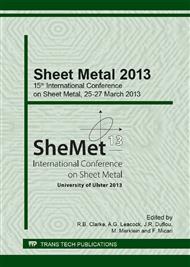p.84
p.92
p.100
p.108
p.117
p.125
p.133
p.141
p.149
Size Effects in Winding Roll Formed Profiles: A Study of Carcass Production for Flexible Pipes in Offshore Industry
Abstract:
Carcass production of flexible offshore oil and gas pipes implies winding and interlocking of a roll formed stainless steel profile around a mandrel in a spiral shape. The location of the dividing point between the left and right half of the s-shaped profile in the finished carcass is very important as it directly influences carcass flexibility. The target location of the dividing point can be difficult to achieve since undesired degrees of freedom in the winding stage allows the profile to change geometry. The present work investigates this issue by performing production tests of a single carcass profile size on three mandrel sizes showing a size effect to be evident; smaller mandrel size increases a shift of the dividing point during initial mandrel contact in the winding stage. The cause is high strains in the open profile, which are minimized by the material moving closer to profile neutral plane. Other parameters such as profile entry angle on the mandrel and spiral pitch are likely to have significant importance. Proper dividing point position is shown to be obtainable by adjusting the profile in the roll forming stage. The profile rolling is successfully modeled by Finite Element Analysis (FEA), whereas a simplified FE-model of the subsequent winding operation shows that full interlock modeling is required for proper prediction of profile deformation.
Info:
Periodical:
Pages:
117-124
Citation:
Online since:
April 2013
Authors:
Price:
Сopyright:
© 2013 Trans Tech Publications Ltd. All Rights Reserved
Share:
Citation:


